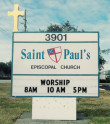Facing Jerusalem
Texts: I Kings 19:15-15, 21, Luke 9:51-62

Sunday Sermon
The Rev. Dr. D. William Faupel
Priest-in-Charge
Jun. 26, 2016
Introduction
I got on the bus, determined in my mind to make the trip an adventure. I had to admit to myself that I was more than a little apprehensive. It was my last year in England. I was making a pilgrimage to Walsingham. For those of you who do not know, Walsingham is to England what Lourdes is to France, a shrine to Mary, the mother of our Lord and a place where many have claimed miraculous healing.
The pilgrimage was taken by the whole congregation of the church I was attending. To help pass the time for the six-hour bus ride, the Vicar had each of us tell a story about an incident in our lives where we had been encountered by the Lord. Time flew. I marveled at the remarkable encounters told by very ordinary people. My respect for them grew as I came to know them at a far deeper level than I had understood them before.
It seemed like only minutes had passed when the Vicar called a halt to this time of “testimony” and began to pass out hymnals. For the last half-hour, as we approached Walsingham, we sang the Saga of the Lady of Walsingham. As a young devout Catholic and the wife of an English nobleman, she fell ill to the point of death. Mary appeared to her in a vision and commanded her to drink from a spring on her husband’s estate. She obeyed and was instantly healed. In gratitude she erected a shrine on the site and eventually had a chapel built.
For years, people came to drink from the healing waters and many recovered from their ailments. Then the tone of the song changed as we sang of the era of Oliver Cromwell, whose armies pulled down the chapel and killed the priests. We sang of how the devout would unstop the spring and tend to the shrine in secret knowing that they would be tortured and put to death if caught. We sang of when finally, the time of persecution passed and the chapel was rebuilt and the pilgrimages resumed. It was Foxes Book of Martyrs in reverse. By the end of the sage I had a much greater appreciation for Chaucer’s “Canterbury Tales.”
I.
The religious pilgrimage has been around for thousands of years. Its origin probably dates back to the time of the Exodus when the Children of Israel fled Egypt and began to observe Passover to commemorate their deliverance from slavery. Once they had settled in the land of promise it became a tradition for people to journey to Jerusalem, the capital city, to celebrate this feast. They were still making this annual pilgrimage during the lifetime of our Lord.
The Gospel of John records Jesus making this journey in each of the three years of his ministry. St. Luke, whose Gospel we have been reading during the course of this year, records only his final journey. He devotes almost one-half of his gospel, chapter 9 through chapter 19, to describe the events and teachings that took place as Jesus made this pilgrimage. For the rest of the church year it will be these events and teachings that we will hear read.
As they traveled, the crowd grew. Luke records that several thousand were making the journey. Our Lord and his disciples join this growing crowd of pilgrims. But instead of each one telling a story like in Canterbury Tales, as Luke tells it, Jesus soon becomes the center of attention. He is asked questions, He tells stories, and from him miracles are sought.
II.
For centuries Biblical scholars puzzled over this travel narrative. It was clear to them that Jesus had set his face toward Jerusalem where he knew he would be put to death. But the journey itself seems aimless. There is no hurry, no clear sense of movement until they reach their destination. Only in recent years has Luke’s strategy become clear.
As Luke tells the story, Jesus journey begins as he come down from the Mount of Transfiguration where he had been conversing with Moses and Elijah. Luke states that the two had been taking about our Lord’s departure which they refer to as his “exodus” that would take place in Jerusalem. Now as he writes of Jesus’ journey he has the original exodus clearly in the back of his mind.
The journey echoes the mindless forty years of the Jews wandering in the wilderness. Luke develops this theme in two ways. First, he understands the journey in the wilderness to be a time when Israel was completely dependent upon God for survival. Second, the teaching of Jesus echoes the speeches Moses gave to his people before they entered the land of promise. He is show that Jesus is the prophet like unto Moses that was promised by the prophets.
The Promise Land was to be a country ruled by the will of God. As God had been faithful to them in delivering them from slavery in Egypt and providing for their needs in the wilderness, he will now cause them to prosper in the land of promise if they remained obedient to Him. Likewise, in Luke’s Gospel, Jesus characterized the coming kingdom by God’s demand for faithfulness, and that God could be trusted to provide for our every need.
III.
Moses was not the only person on the Mount of Transfiguration. Elijah was also there. It is therefore, not surprising that we also find echoes of his ministry in the subsequent ministry of Jesus as he heads toward Jerusalem. The first echo is seen in the opening line of today’s gospel. We know that Jesus sets his face resolutely toward Jerusalem to face the cross. But that is not the reason Luke gives. Rather he states that when the time came for Jesus to be taken up into heaven, he sets out for Jerusalem. In the alternate Old Testament reading this morning, Elijah is taken into heaven in a chariot of fire. And just as Elisha would receive a double portion of the Spirit that had rested on Elijah, so too our Lord’s disciples were promised that they would do greater works than Jesus when the Holy Spirit fell upon them.
But Luke not only shows how Elijah and Jesus were similar, he also points out some contrasts as well. In the Old Testament reading we heard read this morning, we found Elisha plowing on his father’s farm when he receives the call to become Elijah’s disciple. He asks permission to say goodbye to his family. Elijah grants the request and there is much feasting before he goes. But today’s Gospel ends with a pilgrim saying to Jesus, “Lord, I will be your disciple, but first let me say goodbye to my family. Jesus replies, “No one who puts his hand to the plough and looks back is fit for the kingdom of God. Also we find in today’s Gospel that when Jesus is rejected in Samaria, John and James want to call fire down from heaven to destroy them. Jesus rebukes them. They are at the very place were Elijah called fire down from heaven to consume the sacrifice and then proceeded to slaughter the 400 priests of Baal.
IV.
All these allusions may be interesting, you might be thinking, but what does this gospel say to us? I would suggest it says at least four things.
First, throughout its history, the Church has described our life in Christ as a pilgrimage. It is a journey that we do not take alone. We join fellowship with a community of believers who are also making this journey. As we share our life together we learn from one another and offer encouragement and assistance when the going gets rough.
Second, although like Jesus, we are called upon to take up our cross daily, the New Jerusalem not Golgotha is our final destiny. This life on earth is not our final home, it is our training ground. We are being prepared for the life to come. As good as life may be here below, “we ain’t seen nothen yet!”
Third, although there are several occasions when our purpose and destiny are clearly focused, most of our lives are lived like St. Luke’s portrait of Jesus journey to Jerusalem, unhurried, and somewhat aimless. Like Jesus on Hi journey, we are called to focus on what is at hand. It is only as we accomplish what we are called upon to do today, that we are ready to face tomorrow.
Finally, just as today’s Gospel sets forth both continuities and differences with the Old Testament lessons, living life in the “now” call for real decisions and discernment. The Bible is not simply a book of answers telling us how to life your life. Rather, it is a record of how God work with human experience in multitudes of situations. Certainly we look to scripture for guidance. Of course we seek the wisdom of the ages. We would be crazy not to seek the counsel of the community of faith.
But what might be the correct decision in one context could be horribly wrong in another. We need discernment to discover what insight is appropriate for today’s precise situation. Thank God, He has sent us His Holy Spirit to lead us each day.
SUPPORT ST. PAUL'S DONATE NOW OR RECURRING DONATION

3901 Davis Blvd., Naples, Florida 34104 239-643-0197 Office hours 9 a.m. to 1 p.m. Monday-Friday


